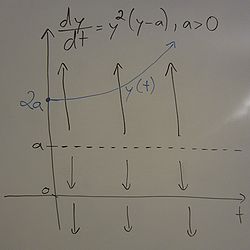Science:Math Exam Resources/Courses/MATH102/December 2013/Question A 08
{{#incat:MER QGQ flag|{{#incat:MER QGH flag|{{#incat:MER QGS flag|}}}}}}
• QA 1 • QA 2 • QA 3 • QA 4 • QA 5 • QA 6 • QA 7 • QA 8 • QB 1 • QB 2 • QB 3 • QB 4 • QB 5 • QB 6 • QB 7 • QB 8 • QC 1 • QC 2(a) • QC 2(b) • QC 2(c) • QC 2(d) • QC 3 • QC 4 •
Question A 08 |
|---|
|
Given the differential equation and initial condition where is a constant, which of the following is true? (a) (b) (c) (d) (e) None of the above. |
|
Make sure you understand the problem fully: What is the question asking you to do? Are there specific conditions or constraints that you should take note of? How will you know if your answer is correct from your work only? Can you rephrase the question in your own words in a way that makes sense to you? |
|
If you are stuck, check the hint below. Consider it for a while. Does it give you a new idea on how to approach the problem? If so, try it! |
Hint |
|---|
|
To find the limit of the solution of a differential equation, start by calculating the steady states (when the derivative is zero). Solutions cannot cross steady states. Also check whether the solution is increasing or decreasing from the initial point. |
|
Checking a solution serves two purposes: helping you if, after having used the hint, you still are stuck on the problem; or if you have solved the problem and would like to check your work.
|
Solution |
|---|
|
To start with, we calculate the steady states, i.e.: Thus the steady states are . The initial condition is , which is above . Since , the solution is increasing away from the steady state to infinity:
|
{{#incat:MER CT flag||
}}













